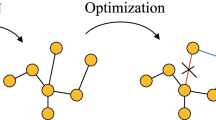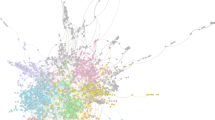Abstract
Success has been obtained using a semi-supervised graph analysis method based on a graph convolutional network (GCN). However, GCN ignores some local information at each node in the graph, so that data preprocessing is incomplete and the model generated is not accurate enough. Thus, in the case of numerous unsupervised models based on graph embedding technology, local node information is important. In this paper, we apply a local analysis method based on the similar neighbor hypothesis to a GCN, and propose a local density definition; we call this method LDGCN. The LDGCN algorithm processes the input data of GCN in two methods, i.e., the unbalanced and balanced methods. Thus, the optimized input data contains detailed local node information, and then the model generated is accurate after training. We also introduce the implementation of the LDGCN algorithm through the principle of GCN, and use three mainstream datasets to verify the effectiveness of the LDGCN algorithm (i.e., the Cora, Citeseer, and Pubmed datasets). Finally, we compare the performances of several mainstream graph analysis algorithms with that of the LDGCN algorithm. Experimental results show that the LDGCN algorithm has better performance in node classification tasks.
Similar content being viewed by others
References
Chen HC, Perozzi B, Al-Rfou R, et al., 2018. A tutorial on network embeddings. https://arxiv.org/abs/1808.02590v1
Fouss F, Pirotte A, Renders JM, et al., 2007. Random-walk computation of similarities between nodes of a graph with application to collaborative recommendation. IEEE Trans Knowl Data Eng, 19(3):355–369. https://doi.org/10.1109/tkde.2007.46
Grover A, Leskovec J, 2016. node2vec: scalable feature learning for networks. Proc 22nd ACM SIGKDD Int Conf on Knowledge Discovery and Data Mining, p.855–864. https://doi.org/10.1145/2939672.2939754
Grover A, Zweig A, Ermon S, 2018. Graphite: iterative generative modeling of graphs. https://arxiv.org/abs/1803.10459v2
Kipf TN, Welling M, 2016. Semi-supervised classification with graph convolutional networks. https://arxiv.org/abs/1609.02907
Langville AN, Meyer CD, 2006. Google’s PageRank and Beyond: the Science of Search Engine Rankings. Princeton University Press, Princeton, USA, p.234.
Le Q, Mikolov T, 2014. Distributed representations of sentences and documents. Proc 31st Int Conf on Machine Learning, p.II-1188–II-1196.
LeCun Y, Boser B, Denker JS, et al., 1989. Backpropagation applied to handwritten zip code recognition. Neur Comput, 1(4):541–551. https://doi.org/10.1162/neco.1989.1.4.541
LeCun Y, Bottou L, Bengio Y, et al., 1998. Gradient-based learning applied to document recognition. Proc IEEE, 86(11):2278–2324. https://doi.org/10.1109/5.726791
LeCun Y, Bottou Y, Hinton G, 2015. Deep learning. Nature, 521(7553):436–444. https://doi.org/10.1038/nature14539
Lin F, Cohen WW, 2010. Semi-supervised classification of network data using very few labels. Int Conf on Advances in Social Networks Analysis and Mining, p.192–199. https://doi.org/10.1109/ASONAM.2010.19
Lorrain F, White HC, 1971. Structural equivalence of individuals in social networks. J Math Soc, 1(1):49–80. https://doi.org/10.1080/0022250X.1971.9989788
Mikolov T, Chen K, Corrado G, et al., 2013. Efficient estimation of word representations in vector space. https://arxiv.org/abs/1301.3781
Mnih A, Kavukcuoglu K, 2013. Learning word embeddings efficiently with noise-contrastive estimation. Proc 26th Int Conf on Neural Information Processing Systems, p.2265–2273.
Narayanan A, Chandramohan M, Chen LH, et al., 2016. subgraph2vec: learning distributed representations of rooted sub-graphs from large graphs. https://arxiv.org/abs/1606.08928
Niepert M, Ahmed M, Kutzkov K, 2016. Learning convolutional neural networks for graphs. Proc 33rd Int Conf on Machine Learning, p.2014–2023.
Page L, Brin S, Motwani R, et al., 1998. The Pagerank Citation Ranking: Bringing Order to the Web. Technical Report SIDL-WP-1999–0120, Stanford InfoLab, Stanford, USA.
Perozzi B, Al-Rfou R, Skiena S, 2014. DeepWalk: online learning of social representations. Proc 20th ACM SIGKDD Int Conf on Knowledge Discovery and Data Mining, p.701–710. https://doi.org/10.1145/2623330.2623732
Pizarro N, 2007. Structural identity and equivalence of individuals in social networks: beyond duality. Int Soc, 22(6):767–792. https://doi.org/10.1177/0268580907082260
Ribeiro LFR, Saverese PHP, Figueiredo DR, 2017. struc2vec: learning node representations from structural identity. Proc 23rd ACM SIGKDD Int Conf on Knowledge Discovery and Data Mining, p.385–394. https://doi.org/10.1145/3097983.3098061
Shuman DI, Narang SK, Frossard P, et al., 2013. The emerging field of signal processing on graphs: extending high-dimensional data analysis to networks and other irregular domains. IEEE Signal Process Mag, 30(3):83–98. https://doi.org/10.1109/MSP.2012.2235192
Tang L, Liu H, 2011. Leveraging social media networks for classification. Data Min Knowl Discov, 23(3):447–478. https://doi.org/10.1007/s10618-010-0210-x
Wang HF, Zhang CY, Lin DY, et al., 2019. An artificial intelligence based method for evaluating power grid node importance using network embedding and support vector regression. Front Inform Technol Electron Eng, 20(6): 816–828. https://doi.org/10.1631/FITEE.1800146
Weston J, Ratle F, Mobahi H, et al., 2012. Deep learning via semi-supervised embedding. In: Montavon G, Orr GB, Müller KR (Eds.), Neural Networks: Tricks of the Trade. Springer, Berlin, Heidelberg, p.639–655. https://doi.org/10.1007/978-3-642-35289-8_34
Yang LM, Zhang W, Chen YF, 2015. Time-series prediction based on global fuzzy measure in social networks. Front Inform Technol Electron Eng, 16(10):805–816. https://doi.org/10.1631/FITEE.1500025
Yang ZL, Cohen WW, Salakhutdinov R, 2016. Revisiting semi-supervised learning with graph embeddings. Proc 33rd Int Conf on Machine Learning, p.40–48.
Author information
Authors and Affiliations
Contributions
Hao WANG designed the research, processed the data, and drafted the manuscript. Li-yan DONG, Tie-hu FAN, and Ming-hui SUN helped organize the manuscript. Hao WANG and Tie-hu FAN revised and finalized the paper.
Corresponding author
Additional information
Compliance with ethics guidelines
Hao WANG, Li-yan DONG, Tie-hu FAN, and Ming-hui SUN declare that they have no conflict of interest.
Project supported by the National Natural Science Foundation of China (Nos. 61272209 and 61872164)
Rights and permissions
About this article
Cite this article
Wang, H., Dong, Ly., Fan, Th. et al. A local density optimization method based on a graph convolutional network. Front Inform Technol Electron Eng 21, 1795–1803 (2020). https://doi.org/10.1631/FITEE.1900663
Received:
Accepted:
Published:
Issue Date:
DOI: https://doi.org/10.1631/FITEE.1900663




